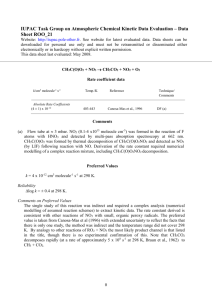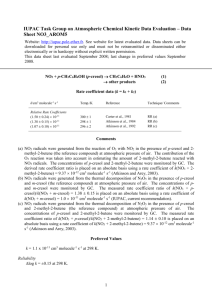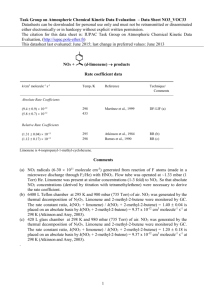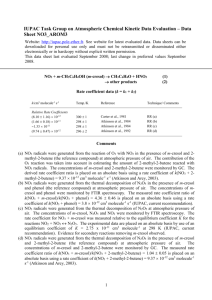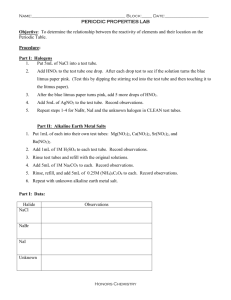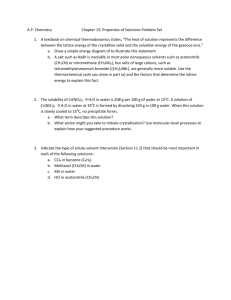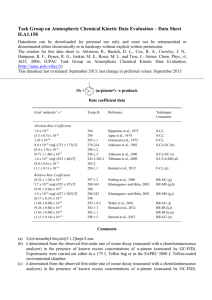Word - IUPAC Task Group on Atmospheric Chemical Kinetic Data
advertisement
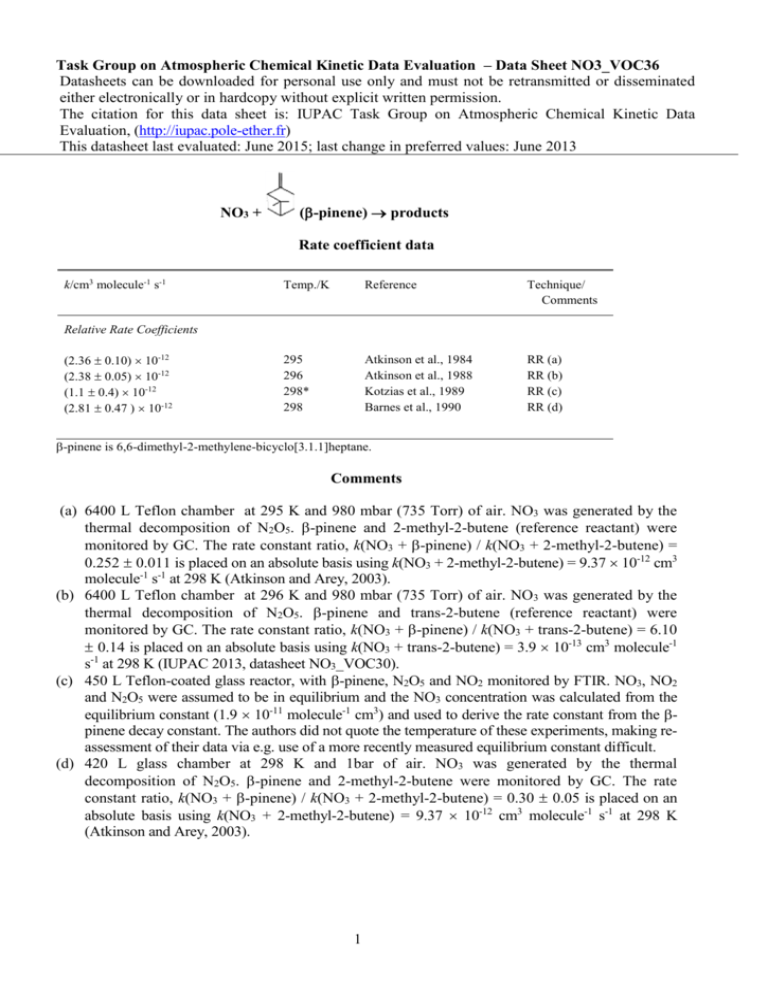
Task Group on Atmospheric Chemical Kinetic Data Evaluation – Data Sheet NO3_VOC36 Datasheets can be downloaded for personal use only and must not be retransmitted or disseminated either electronically or in hardcopy without explicit written permission. The citation for this data sheet is: IUPAC Task Group on Atmospheric Chemical Kinetic Data Evaluation, (http://iupac.pole-ether.fr) This datasheet last evaluated: June 2015; last change in preferred values: June 2013 NO3 + (-pinene) products Rate coefficient data k/cm3 molecule-1 s-1 Temp./K Reference Technique/ Comments 295 296 298* 298 Atkinson et al., 1984 Atkinson et al., 1988 Kotzias et al., 1989 Barnes et al., 1990 RR (a) RR (b) RR (c) RR (d) Relative Rate Coefficients (2.36 0.10) 10-12 (2.38 0.05) 10-12 (1.1 0.4) 10-12 (2.81 0.47 ) 10-12 -pinene is 6,6-dimethyl-2-methylene-bicyclo[3.1.1]heptane. Comments (a) 6400 L Teflon chamber at 295 K and 980 mbar (735 Torr) of air. NO3 was generated by the thermal decomposition of N2O5. -pinene and 2-methyl-2-butene (reference reactant) were monitored by GC. The rate constant ratio, k(NO3 + -pinene) / k(NO3 + 2-methyl-2-butene) = 0.252 0.011 is placed on an absolute basis using k(NO3 + 2-methyl-2-butene) = 9.37 10-12 cm3 molecule-1 s-1 at 298 K (Atkinson and Arey, 2003). (b) 6400 L Teflon chamber at 296 K and 980 mbar (735 Torr) of air. NO3 was generated by the thermal decomposition of N2O5. -pinene and trans-2-butene (reference reactant) were monitored by GC. The rate constant ratio, k(NO3 + -pinene) / k(NO3 + trans-2-butene) = 6.10 0.14 is placed on an absolute basis using k(NO3 + trans-2-butene) = 3.9 10-13 cm3 molecule-1 s-1 at 298 K (IUPAC 2013, datasheet NO3_VOC30). (c) 450 L Teflon-coated glass reactor, with -pinene, N2O5 and NO2 monitored by FTIR. NO3, NO2 and N2O5 were assumed to be in equilibrium and the NO3 concentration was calculated from the equilibrium constant (1.9 10-11 molecule-1 cm3) and used to derive the rate constant from the pinene decay constant. The authors did not quote the temperature of these experiments, making reassessment of their data via e.g. use of a more recently measured equilibrium constant difficult. (d) 420 L glass chamber at 298 K and 1bar of air. NO3 was generated by the thermal decomposition of N2O5. -pinene and 2-methyl-2-butene were monitored by GC. The rate constant ratio, k(NO3 + -pinene) / k(NO3 + 2-methyl-2-butene) = 0.30 0.05 is placed on an absolute basis using k(NO3 + 2-methyl-2-butene) = 9.37 10-12 cm3 molecule-1 s-1 at 298 K (Atkinson and Arey, 2003). 1 Preferred Values Parameter k /cm3 molecule-1 s-1 Value T/K 2.5 10-12 298 ± 0.12 298 Reliability log k Comments on Preferred Values The relative rate studies of this reaction which employed either 2-methyl-2-butene or trans-2butene as reference reactant s are in broad agreement, though there is no obvious reason why Atkinson et al. (1984) and Barnes et al. (1990), who used the same reference reactant should derive rate coefficients which diverge by ~20 %. These studies are preferred over that of Kotzias et al., as there are greater uncertainties related to using the strongly temperature dependent equilibrium constant for the NO2 + NO3 = N2O5 reaction, which are compounded by the fact that authors did not cite their experimental temperature. The preferred value of the 298 K rate coefficient is thus an unweighted average of the results derived by Atkinson et al. (1984, 1988) and Barnes et al. (1990). The reaction mechanism involves the addition of NO3 across the double bond to form a nitrooxyalky radical, which, in air, forms a nitrooxyalkyl peroxy radical. Hallquist et al. (1999) identified the end products nopinone (molar yields of 1-2 %), carbonyls (estimated molar yield of 12-14 %) and organic nitrates (estimated molar yield of 61-74 %) which were also observed using FTIR and MS by Kotzias et al. (1989), but not quantified. Using thermal dissociation of alkyl nitrates and peroxynitrates coupled to LIF detection of NO2, Fry et al., (2009) derived a molar organic nitrate yield of ~40 %. Later, similar experiment using the same method (Fry et al. 2014) resulted in a total (gas- and aerosol) yield of 0.22 with 76 % being located in the aerosol phase. Organonitrates were found to comprise 56 % of the aerosol mass. Secondary organic aerosol formation was also observed in the smog-chamber studies of NO3 + pinene (Hallquist et al., 1999; Griffin et al. 1999), with mass-based yields of up to 90 % depending on the amount of -pinene reacted. References Atkinson, R., Aschmann, S. M., Winer, A. M., and Pitts, J. N., Env. Sci. Tech., 18, 370-375, 1984. Atkinson, R., and Arey, J., Chem. Rev., 103, 4605-4638, 2003. Barnes, I., Bastian, V., Becker, K. H., and Tong, Z., J. Phys. Chem., 94, 2413-2419, 1990. Fry, J. L., Kiendler-Scharr, A., Rollins, A. W., Wooldridge, P. J., Brown, S. S., Fuchs, H., Dube, W., Mensah, A., dal Maso, M., Tillmann, R., Dorn, H. P., Brauers, T., and Cohen, R. C., Atmos. Chem. Phys., 9, 1431-1449, 2009. Fry, J. L., Draper, D. C., Barsanti, K. C., Smith, J. N., Ortega, J., Winkle, P. M., Lawler, M. J., Brown, S. S., Edwards, P. M., Cohen, R. C., and Lee, L., Env. Sci. Tech., 48, 11944-11953, 2014. Griffin, R. J., Cocker, D. R., Flagan, R. C., and Seinfeld, J. H., J. Geophys. Res.-Atmos., 104, 35553567, 1999. Hallquist, M., Wangberg, I., Ljungstrom, E., Barnes, I., and Becker, K. H., Env. Sci. Tech., 33, 553559, 1999. 2 IUPAC, Subcommittee for gas kinetic data evaluation. (Ammann, M., Atkinson, R., Cox, R.A., Crowley, J.N., Hynes, R. G., Jenkin, M.E., Mellouki, W., Rossi, M. J., Troe, J. and Wallington, T. J.) Evaluated kinetic data: http://www.iupac-kinetic.ch.cam.ac.uk/, 2013. Kotzias, D., Hjorth, J. L., and Skov, H., Toxicol. Environ. Chem., 20-1, 95-99, 1989. 3
